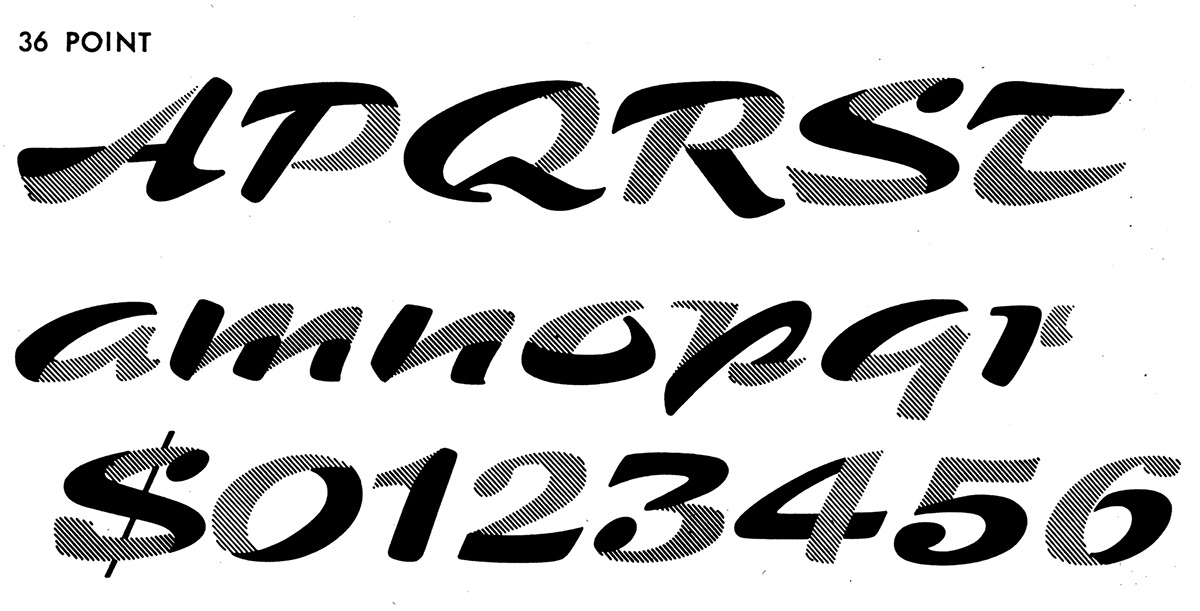
P22 Zebra font set - by Karlgeorg Hoefer

Original specimens from the Stempel Foundry (Image courtesy Otmar Hoefer)
Karlgeorg Hoefer (1914–2000) was a highly accomplished calligrapher, type designer, and educator in the lettering arts. His typefaces have been released by the notable German foundries Ludwig & Mayer, Klingspor, Stempel, and Linotype.
In the summer of 2007, P22’s International House of Fonts introduced an historic Hoefer design not previously available in the digital era.
Zebra was originally designed by Karlgeorg Hoefer in 1965 for the Stempel foundry in Germany. This unique font was designed as a two-color script face and is now available digitally for the first time. The P22/IHOF release presents six separate fonts based on the original painted drawings and Stempel proofs.
In the summer of 2007, P22’s International House of Fonts introduced an historic Hoefer design not previously available in the digital era.
Zebra was originally designed by Karlgeorg Hoefer in 1965 for the Stempel foundry in Germany. This unique font was designed as a two-color script face and is now available digitally for the first time. The P22/IHOF release presents six separate fonts based on the original painted drawings and Stempel proofs.

36 Point showing of Zebra from metal type specimen book

Original gouache drawings from Karlgeorg Hoefer (Image courtesy Otmar Hoefer)

Proofs from the Stempel Foundry (Image courtesy Otmar Hoefer)

Original specimens from the Stempel Foundry (Image courtesy Otmar Hoefer)
Hoefer spent much of his professional life in the typographically rich city of Offenbach, near Frankfurt. The city’s other typographic luminaries include Peter Behrens and Rudolf Koch. Much of Hoefer’s work can be found in the Klingspor Museum there.
The type designs of Karlgeorg Hoefer range from his first type, Salto (1952), its 1950s flair derived from his broad-nibbed pen style of writing, to one of his last designs, Sho, which came forty years later. Sho is a script formed from bold brush strokes which, in isolation, almost defy the glyphs they are intended to define. Hoefer has also created blackletter and other script faces as well as the 1970s-era “FE-Schrift (short for fälschungserschwerende Schrift, or falsification-hindering script) conceived for German license plates. This design employs anti-counterfeiting techniques and, after years of development (and time spent lost in the archives of the transportation ministry), debuted in 2001 on the new German plates. Hoefer’s gift for type design is but one facet of his lettering artistry. His calligraphic style has influenced a number of contemporary lettering artists, including Richmond, Virginia’s Michael Clark. “Hoefer was, and remains, the king of brush lettering in Germany. Nobody even came close,” Clark says. One piece done by Hoefer, a journal cover for the Calligraphic Society of Los Angeles, featured a striking blackletter done with a pointed brush. His most famous blackletters are the typefaces Notre Dame and San Marco. In the early 1990s, lettering master Julian Waters taught with Hoefer at his open calligraphy workshop in Offenbach, Schreibwerkstatt Klingspor. Waters says that Hoefer’s typefaces carry his characteristic brush writing style. Several of Hoefer’s designs, including Salto and Big Band, have been digitized and issued by various foundries. Zebra was not previously digitized
The type designs of Karlgeorg Hoefer range from his first type, Salto (1952), its 1950s flair derived from his broad-nibbed pen style of writing, to one of his last designs, Sho, which came forty years later. Sho is a script formed from bold brush strokes which, in isolation, almost defy the glyphs they are intended to define. Hoefer has also created blackletter and other script faces as well as the 1970s-era “FE-Schrift (short for fälschungserschwerende Schrift, or falsification-hindering script) conceived for German license plates. This design employs anti-counterfeiting techniques and, after years of development (and time spent lost in the archives of the transportation ministry), debuted in 2001 on the new German plates. Hoefer’s gift for type design is but one facet of his lettering artistry. His calligraphic style has influenced a number of contemporary lettering artists, including Richmond, Virginia’s Michael Clark. “Hoefer was, and remains, the king of brush lettering in Germany. Nobody even came close,” Clark says. One piece done by Hoefer, a journal cover for the Calligraphic Society of Los Angeles, featured a striking blackletter done with a pointed brush. His most famous blackletters are the typefaces Notre Dame and San Marco. In the early 1990s, lettering master Julian Waters taught with Hoefer at his open calligraphy workshop in Offenbach, Schreibwerkstatt Klingspor. Waters says that Hoefer’s typefaces carry his characteristic brush writing style. Several of Hoefer’s designs, including Salto and Big Band, have been digitized and issued by various foundries. Zebra was not previously digitized



